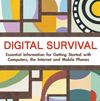- The Computer
- The Internet
- The Mobile Phone
Mobile phone security checklist
- When using your phone, remain aware of your surroundings and do not use it in crowded areas or where you feel unsafe.
- Avoid displaying your phone in public. Keep it with you at all times and do not leave it unattended.
- Always use a PIN code to unlock your phone's keypad and functions. See the phone's security settings to set this. Use invisible ink to mark the phone and battery with your postcode and street number or the first two letters of your house name. This can be helpful in recovering your phone if it is lost or stolen.
- The 15-digit serial or IMEI number helps to identify your phone. This can be accessed by looking behind the battery of your phone – it should be visible as a 15 digit number. Make a note of this number and keep it separate from your phone, as this number could help the police to trace ownership quickly if it is stolen.
For more information, visit the Security section of the Mobiles in-a-box toolkit (http://mobiles.tacticaltech.org/security)

